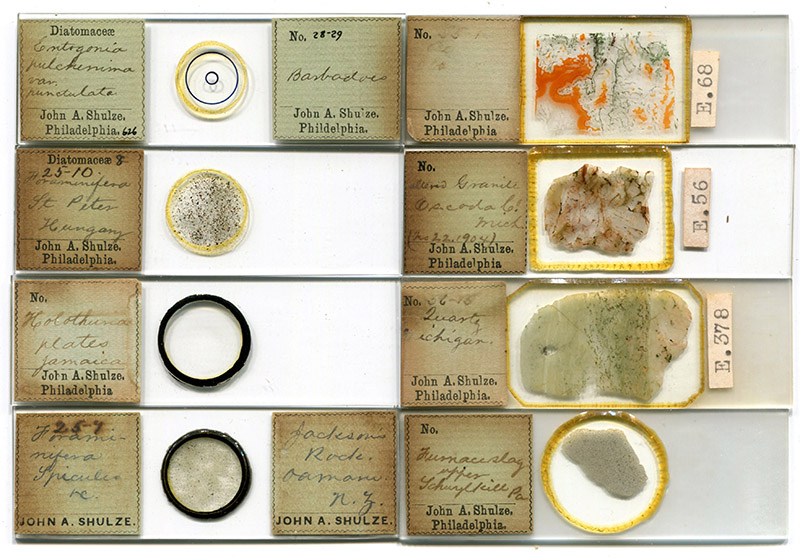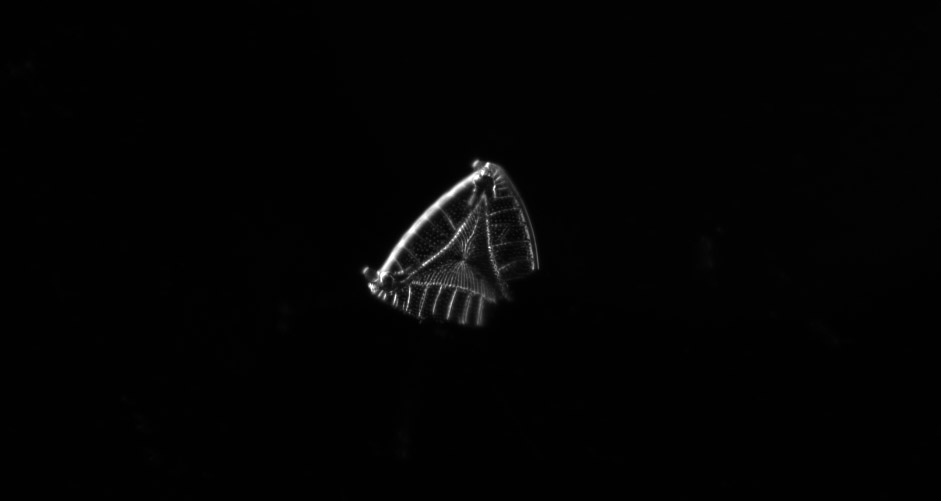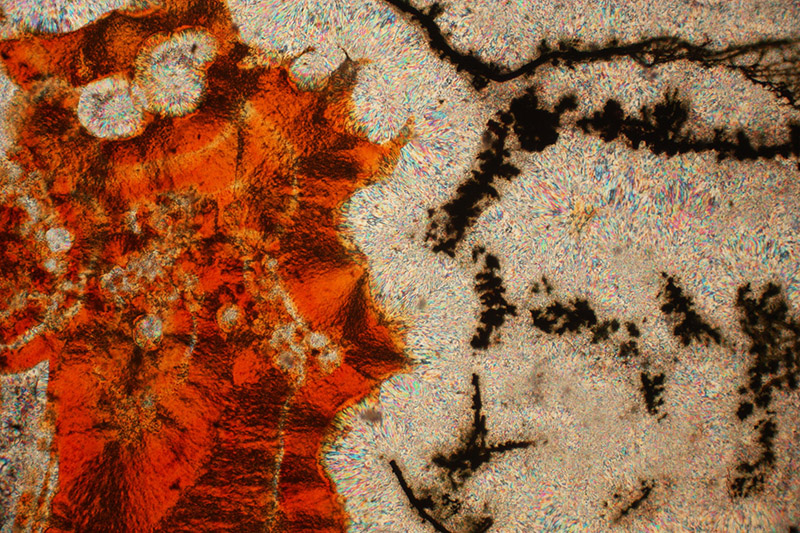John Andrew Shulze, 1839-1931
by Brian Stevenson
last updated August, 2016

Figure 1.
Examples of microscope slides by John A. Shulze. He was best known in his day for mounting selected diatoms, such as the upper left-hand slide. Shulze mounted a number of other subjects, including foraminifera, spicules and other hard tissues from sea life, and thin-sections of minerals.
An amateur scientist, John Shulze became an expert in the study of diatoms, and was listed as such in listed in Harshberger’s 1899 Botanists of Philadelphia and Their Work. He left a collection of approximately 4800 microscope slides of diatoms and 3661 unmounted samples to the Academy of Natural Sciences of Philadelphia. A sizeable collection of Shulze’s diatomaceous material is also held by Harvard University.
John Andrew Shulze was born on September 5, 1839, in Williamsport, Pennsylvania, USA. He was the second of two children, and the only son, of Augustus and Emily Shulze. His paternal grandfather, John Andrew Melchior Shulze, served as Governor of Pennsylvania from 1823 until 1829. Grandfather Shulze was a banker, and records suggest that our microscopist followed a similar line of business.
John married Edith Miller on December 4, 1868. They had one child, Charles Augustus Shulze, born in 1873, and died in 1925.
Shulze was a member of two important Philadelphia scientific societies, joining The Franklin Institute before 1890, and The Academy of Natural Sciences of Philadelphia in October, 1892. He was a member of the Leidy Microscopical Society, which was a society within the Academy of Natural Sciences. Considering his age when joining the Academy and the Leidy Society, Shulze probably adopted microscopy as a hobby to keep him active during retirement.
In honor of his work, at least two diatom species were named after Shulze. His friend, Charles S. Boyer, named Biddulphia shulzei in 1899, a “fossil in the artesian well deposit at Weymouth, N.J. I have seen but one specimen which was found by Mr. John A. Shulze”. in 1908, Boyer named Cymatopleura shulzei, “Since the publication of Greville's papers on the Diatomaceae but few new forms from the deposit of Barbadoes have been described with the exception of those named by the late Prof. J. Brun in the last number of Le Diatomiste. The deposit, however, is very rich, and Mr. John A. Shulze, of Philadelphia, has not only prepared and mounted the greater number of Greville's rare species, but has discovered several new ones. Among these may be mentioned a Cymalopleura … I take pleasure in naming this species after Mr. John A. Shulze. whose preparations of selected diatoms is unexcelled”.
In addition to numerous exhibits and donations of diatom preparations to his scientific societies, Shulze is recorded as displaying various other items. In 1899, at the Franklin Institute’s seventy-fifth anniversary, he showed “a tray of coral pebbles, cyathophyllum rugosum, that were collected … from the northern part of the southern peninsula of Michigan … some of which had been polished and as a result their radiate structure was well known”. In 1903, Shulze and Boyer donated to the Academy of Natural Sciences of Philadelphia “five species of fresh-water shells from South America”.
John Shulze died on October 1, 1931. He was then 92 years old.
A final note, on mortality. The Guide to the Manuscript Collections in the Academy of Natural Sciences of Philadelphia was published in 1963, 32 years after Shulze’s death. Regarding Shulze’s donations, it noted that “he was an active member of the Leidy Microscopical Society and an ardent student of diatoms. he bequeathed a microscope to the Academy which is in the Leidy historic collection, and his complete personal collection of diatoms, the latter with some type material”. The brief biographical sketch in the Guide says, “During the First World War Shulze came to this country, leaving his fatherland for the freedom of the U.S.A.”, which is completely wrong. Collectors take heed: if you plan to donate your collections to societies, schools, etc., consider also providing some history on yourself.

Figure 2.
A single fossil Entogonia pulcherrima diatom from Barbados, mounted by John A. Shulze (upper left slide of Figure 1). Photographed in black-and-white with oblique lighting and a 20x objective lens.

Figure 3.
Thin section of agate, by John A. Shulze (upper right slide of Figure 1). Viewed with a 10x objective lens and crossed polarizing filters.
Resources
Boyd’s Blue Book (1889) “Shulze John A., Bingham House”, page 426
Boyer, Charles A. (1899) Seven new species of diatoms, The American Monthly Microscopical Journal, Vol. 20, pages 105-108
Boyer, Charles A. (1908) A new species of Cymatopleura, Proceedings of the Academy of Natural Sciences of Philadelphia, page 554
Death record of John A. Shulze (1931) obtained through ancestry.com
Harshberger, John A. (1899) “Shulze, John A. Philadelphia. (Diatoms)”, The Botanists of Philadelphia and Their Work, Harshberger, Philadelphia, page 413
Harvard University John A. Shulze Collection, http://www2.huh.harvard.edu/diatom/shulzecat.htm
John Andrew Shulze family tree (accessed July, 2016) http://person.ancestry.co.uk/tree/16028549/person/18044765336/facts
Journal of the Franklin Institute (1890) “Members of the Franklin Institute … Shulze, Jno. A., Bingham House” , Vol. 129, page xx
Philadelphia City Directory (1867) “Shulze John A., Secretary & Treasurer, 31 Merchants’ Exchange, h Camden”, page 1153
Philadelphia City Directory (1870) “Shulze John A., clerk, 31 Exchange pl, h 1020 Vine”, page 1387
Philadelphia City Directory (1872) “Shulze John A., clerk, 31 Merchants’ Exchange, h 1621 Race”, page 1204
Philadelphia City Directory (1880) “Shulze John A., h 921 Ridge av”, page 1539
The Philadelphia Times (1899) The complete record of the Franklin Institute’s seventy-fifth anniversary, October 8
Phillips, Venia T., Maurice E. Phillips (1963) “During the First World War Shulze came to this country, leaving his fatherland for the freedom of the U.S.A. He was an active member of the Leidy Microscopical Society and an ardent student of diatoms. he bequeathed a microscope to the Academy which is in the Leidy historic collection, and his complete personal collection of diatoms, the latter with some type material. Anecdotes about the man indicate a great friendship between him and Mr. Keeley. A story is told about Keeley going to Shulze's home and finding him down on the floor with a magnifying glass, trying to find a diatom he had dropped on the rug.”, Guide to the Manuscript Collections in the Academy of Natural Sciences of Philadelphia, Edwards, Philadelphia, page 166
Potapova, Marina (2010) The ANSP Diatom Herbarium: an important resource for diatom research, Proceedings of the Academy of Natural Sciences of Philadelphia, Vol. 160, pages 3012
Proceedings of the Academy of Natural Sciences of Philadelphia (1892) “October 25 … The following were elected members: … John A. Shulze”, page 330
Proceedings of the Academy of Natural Sciences of Philadelphia (1903) “The Biological And Microscopical Section … The following additions have been made … slides of diatoms, by Mr. W.B. Davis, Mr. John A. Shulze and Mr. C.S. Boyer”, page 813
Proceedings of the Academy of Natural Sciences of Philadelphia (1903) “Additions to the Museum … Mollusks … A.C. Boyer and J.A. Shulze. Five species of fresh-water shells from South America,” page 829
Science (1896) Notes on a meeting of the Academy of Natural Sciences of Philadelphia, “Preparations of minerals containing diatoms in transverse section and other microscopic arrangements of diatoms prepared by Mr. John A. Schulze were exhibited by Mr. F.J. Keeley”, Vol. 3, page 373
The Scientists’ International Directory (1896) “Shulze, John A., Bingham House, Philadelphia, Penn. Diatoms. C. Ex.”, S.E. Cassino, Boston, page 178
Woolman, Lewis (1895) “Three cleanings of the diatoms in this bed, from the matrix containing them, have been separately made for the writer by C.L. Peticolas, C.S. Boyer and John A. Schulze”, Artesian wells in southern New Jersey, in Geological Survey of New Jersey, Annual Report of the State Geologist for 1894, pages 153-221


